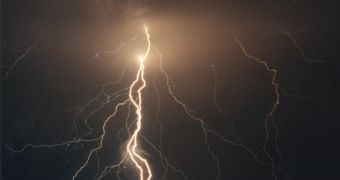First, let's see what you did know about lightning. You probably know that it's an atmospheric discharge of electricity, occurring during rain storms. You're right. Now let's see if you also knew this:
1 - Lightning can form without rain storms.
Yes, it's true. Lightning can also occur during volcanic eruptions or dust storms, and doesn't really require massive cloud formations. Lightning has been observed striking the Apollo 12 soon after takeoff, and was even recorded striking soon after thermonuclear explosions. Some of the largest volcanic eruptions can trigger lightning, due to the gases and solid material they eject high into the atmosphere.
2 - Lightning can form on other planets
While it's true that it cannot form in the vacuum of space, requiring the electrical breakdown of gas, lightning has been spotted in the atmospheres of planets like Venus and Jupiter. On the gas giant, it can be 100 times more powerful, though 15 times less frequent, than on Earth.
3 - Lightning can and does strike the same place twice
In fact, lightning favors certain spots, particularly high locations, like trees and buildings. The Empire State Building is struck by lightning on average 23 times each year, and was once struck 8 times in 24 minutes. Actually, most lightning strikes are made up of multiple individual strokes, meaning that what we see as a pulsating lightning actually consists of three or four different strokes following the same pathway.
4 - Lightning can strike from ground to the clouds
Also true. Called positive lightning, this type makes up less than 5% of all lightning. It forms when cloud tops become positively charged and the ground is negatively charged. When the tension is high enough, electrons from the ground will "climb" to the top of the cloud, forming an inverted lightning. They usually carry about ten times as much current as a bolt of negative lightning, the "normal" one.
5 - Lightning can appear as a sphere
There are many historical accounts of spherical lightnings, or "ball lightnings". A ball lightning has the strange tendency to float (or hover) in the air and take on a ball-like appearance. Many witnesses reported them as being red to yellow in color, sometimes transparent, and some containing radial filaments or sparks. Other colors, such as blue or white occur as well. Recent laboratory experiments are just beginning to shed light on the nature of ball lightning, a phenomenon that has baffled scientists for centuries.
6 - What is the thunder?
The thunder is the noise heard after the lightning occurred. It's actually an explosion of the air molecules in the discharge channel, a rapid expansion caused by the electrical discharge. The rolling and gradually dissipating rumble of thunder is caused by the time delay of sound coming from different portions of a long stroke.
7 - Can a lightning strike out of the blue?
Yes, a lightning can really strike without a thunderstorm being present in the area. This is not the type of lightning previously mentioned, it's actually a weather phenomenon that scientists dubbed as ''bolt from the blue'' or ''dry lightning'' because it falls from clear, blue skies.
David Canales, 41, of West Miami-Dade, US, was killed last week after a lightning came apparently out of nowhere, struck a tree nearby and then the unfortunate man. This unusual lightning packs a bigger, deadlier punch and forms differently, being able to carry as much as 10 times the current, is hotter and lasts longer.
So, with lightning striking the Earth around 100 times every second, on average, this is one of nature's deadliest forces, that may unintentionally affect our life in dramatic ways, and can even bring it to an abrupt end.

 14 DAY TRIAL //
14 DAY TRIAL //